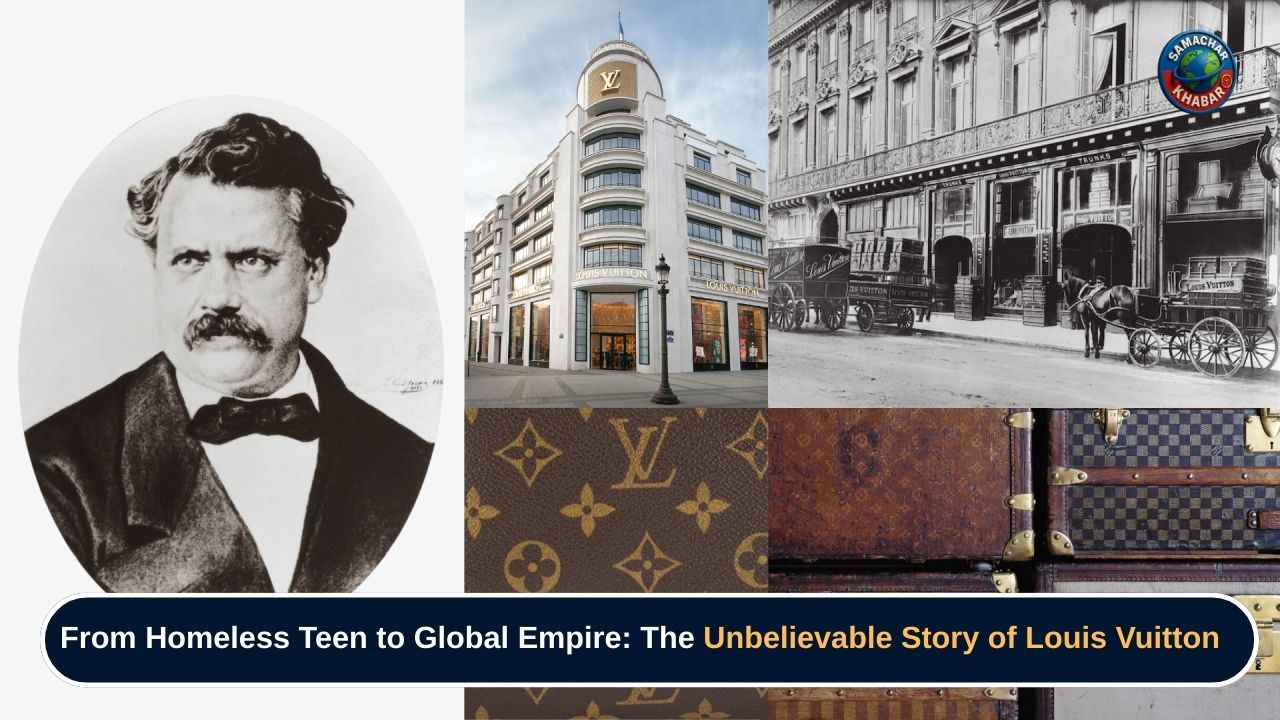In 1835, a 13-year-old boy fled a life of crushing poverty and abuse in rural France, his heart heavy but his spirit unbroken. He had nothing but the clothes on his back and a stubborn will to survive. He began a grueling 292-mile journey to Paris on foot, a two-year odyssey fueled by desperation and the flickering hope of a different life. That boy was Louis Vuitton.
He could never have fathomed that his name would one day become the most powerful symbol of luxury in the world, a global empire built on a saga of grit, genius, and ruthless ambition. This is the story of how a destitute runaway built a brand so desirable that its products can yield better returns than gold.
A 292-Mile Walk to Destiny: The Early Life of Louis Vuitton
Born on August 4, 1821, in the sleepy village of Anchay, Louis Vuitton’s early life was one of relentless hardship. His father was a farmer, his mother a hat-maker, and their world was defined by what they lacked. Tragedy struck when he was just ten, his mother passed away, leaving a void that was soon filled by a cruel stepmother. For three agonizing years, Louis endured her mistreatment until, with the quiet desperation of a cornered animal, he decided to escape.
His flight to Paris was a desperate gamble. The two-year journey was a crucible that forged his character, a daily struggle for survival that instilled in him an unwavering resolve. When he finally arrived in Paris in 1837, the city was electric with the energy of the industrial revolution. The advent of railway travel was transforming society, and with it came a surging demand for sturdy, reliable luggage.
His timing was a stroke of destiny. Louis found work as an apprentice to Monsieur Maréchal, a respected craftsman of custom boxes. For 16 years, he poured his soul into his craft, mastering it with a devotion that bordered on obsession. His reputation for excellence soon reached the highest echelons of French society. In 1852, his life changed in a heartbeat. Empress Eugénie, wife of Emperor Napoleon III, appointed him as her personal box-maker. In an instant, the boy who had slept in forests was crafting luggage for royalty, his past a distant, painful memory.
Revolutionizing an Industry: The Flat-Top Trunk
On April 22, 1854, Louis married and opened his own workshop at 4 Rue Neuve-des-Capucines. It was here that a spark of genius led to an innovation that would redefine travel. At the time, luggage trunks had rounded, dome-shaped tops, a design vestige from the era of horse-drawn carriages. While practical then, these trunks were a logistical nightmare for trains; they were heavy, unwieldy, and impossible to stack.

Louis Vuitton envisioned a better way. He designed a revolutionary flat-top trunk made from a durable yet lightweight grey Trianon canvas. This seemingly simple change was a moment of revelation. The rectangular shape allowed the trunks to be stacked neatly, a perfect marriage of form and function for the modern traveler.
The elite of Paris immediately embraced the design, and its fame soon rippled across the globe, capturing the imagination of the world’s wealthiest and most powerful figures. The Viceroy of Egypt was so impressed that he made Louis Vuitton an official royal supplier. This royal seal of approval was just the beginning.
The Maharajas of India, renowned for their opulent lifestyles, became some of the brand’s most enthusiastic patrons. The King of Kapurthala, Jagatjit Singh, commissioned over 60 custom trunks for his clothes, swords, and turbans. The King of Baroda, Sayajirao Gaikwad III, became a regular, while the King of Jammu and Kashmir, Hari Singh, once ordered 38 bespoke trunks in just seven months, with special designs for everything from his polo outfits to drying his cigarettes.
These were no longer just boxes; they were symbols of status, essential companions for a life of unparalleled luxury.
The Son’s Vision: Securing a Legacy
As the brand’s fame grew, so did the shadow of imitation. Counterfeiters began flooding the market with cheap knock-offs, threatening to dilute the very essence of the brand. After the Franco-Prussian War of 1870 devastated his business, forcing him to rebuild from the ashes Louis and his son, Georges Vuitton, became fiercely protective of their creation. Their solution was twofold and brilliant.

First, they addressed the rampant issue of theft. In a stroke of genius, they invented and patented the Tumbler Lock, an unpickable multi-pin system that was a marvel of engineering. To prove its invincibility, Georges issued a public challenge to the world-famous escape artist Harry Houdini. Houdini wisely declined, and the lock’s reputation for impenetrability was sealed in legend.
Also Read: NASA Wants a Nuclear Reactor on the Moon—Here’s the Real Reason Why
Second, to create an unmistakable identity, Georges introduced the iconic LV Monogram canvas in 1896. A deeply personal tribute to his father who had passed in 1892, the design featured interlocking L and V initials alongside stylized flowers inspired by Japanese motifs. It was more than a pattern; it was a signature, a promise of authenticity that was meticulously handcrafted and impossible to forge. The legacy was now secure, etched into the very fabric of the brand.
A Dark Chapter: Controversy and Collaboration
Gaston-Louis Vuitton inherited the business in 1936, just as the world was descending into the madness of another war. The Nazi occupation of France represents a deeply chilling and controversial period in the company’s history.
As detailed in the book Louis Vuitton: A French Saga, while most Parisian businesses closed in protest of the Nazi-backed Vichy regime, the Louis Vuitton store remained open.

The company collaborated with the regime, a moral compromise that allowed it to profit while others suffered. This decision, later defended as a necessary tactic for survival, left an indelible stain on its reputation, a shadow that looms large over its history.
After the war, this grim pragmatism ironically gave LV a commercial advantage, allowing it to recover and expand with astonishing speed.
The Battle for the Brand: Enter Bernard Arnault
After Gaston-Louis’s death in 1970, the company faltered. Its revival came under Henry Racamier, a savvy steel executive who had married into the Vuitton family. Racamier was a visionary who transformed LV into a modern corporation, taking it public in 1984. By 1987, sales had reached an astonishing $1 billion.
This success, however, painted a target on its back. To fend off hostile takeovers, Racamier orchestrated a merger with the spirits conglomerate Moët Hennessy, creating LVMH (Louis Vuitton Moët Hennessy).

But the alliance was poisoned by mistrust and infighting. In a fatal error, both sides brought in an outside investor to bolster their control: a shrewd and ambitious businessman named Bernard Arnault.
Known as “the wolf in the cashmere coat,” Arnault masterfully exploited the family feud. He played both sides against each other, systematically acquiring a controlling stake in LVMH. By 1989, in a stunning boardroom coup, he had ousted both founding families.
The Vuitton family, who had poured their heart and soul into the brand for generations, felt the sting of betrayal as they were completely exiled from the kingdom their patriarch had built.
The Arnault Era: Building a Global Luxury Monopoly
Under Bernard Arnault, LVMH became the world’s undisputed luxury titan. His strategy was one of relentless, Napoleonic expansion. He acquired over 75 prestigious houses, including Christian Dior, Fendi, and Tiffany & Co., creating an empire that stretched across the entire landscape of luxury.

His audacious and ultimately failed takeover attempts of rivals Gucci and Hermès became the stuff of legend, cementing his reputation as the most formidable and feared leader in the industry.
Crafting Desire: The Secrets Behind the LV Mystique
The modern Louis Vuitton brand maintains its god-like status through a carefully managed strategy of exclusivity and engineered desire.
A Strict No-Discount Policy
You will never see a Louis Vuitton product on sale. To maintain an aura of unwavering value, the company famously chooses to destroy any unsold inventory. This brutal policy, while environmentally controversial, sends a clear message: the value of a Louis Vuitton piece is absolute and non-negotiable.
Meticulous Craftsmanship
LV preaches a gospel of handmade heritage. Each bag is said to undergo hundreds of steps, with over 30 artisans involved in its creation. Zippers are tested 5,000 times, and bags are drop-tested with weights. This narrative of meticulous, near-obsessive quality justifies its astronomical price tags.
Prime Retail Real Estate
The brand’s boutiques are temples of luxury, occupying the most expensive and sought-after real estate in the world. These stores are more than retail spaces; they are declarations of power and permanence, reinforcing the brand’s elite status in the minds of consumers.
Aggressive Legal Protection
LVMH employs a formidable legal army to protect its intellectual property with terrifying ferocity. The company has famously sued everyone from pop stars to blockbuster films for the slightest perceived infringement, ensuring its name and likeness remain sacred and untouchable.
Scrutiny in the Spotlight: Modern Allegations
Despite its pristine image, the brand has faced damning modern controversies. A report by The Guardian alleged that Louis Vuitton misleads consumers with its “Made in France” label, claiming much of the labor is outsourced to low-wage factories in Romania. Furthermore, the animal rights organization PETA has waged a relentless campaign against LV for its use of exotic skins, exposing grim truths that clash violently with the brand’s polished and elegant facade.
A Spiritual Reflection on a Material Legacy
From the spiritual perspective of Sant Rampalji Maharaj, the Louis Vuitton saga is a powerful lesson on the fleeting nature of worldly success. The family’s vast fortune proved temporary, ultimately falling into the hands of an outsider, which shows that all material empires are an illusion before the finality of death. And when human desires start taking tolls on the lives of others, it leads only to unrest and unease.
These teachings explain that worldly success is often the result of spending accumulated merits (punya) from past lives. Those without such merits can only rely on the Supreme God to overcome their misery. As taught by the Supreme God Kabir, life’s true purpose is to worship God and seek liberation from this mortal world.
The negative force of Kaal corrupts this goal, twisting practical necessities like luggage into objects of empty desire that make us waste our lives and resources.
Ultimately, this viewpoint holds that the true goal is not to build a material dynasty but to lead a simple life of worship, follow the scriptures, and attain the eternal, true realm of Satlok. The Vuitton story thus serves as a cautionary tale about the vanity of worldly pursuits.
An Enduring Symbol
The name Louis Vuitton represents far more than a monogram on a handbag; it is a chronicle of human ambition in all its forms. The story began with the weary footsteps of a desperate boy whose simple, brilliant innovation solved a practical problem. It was nurtured by a son’s devotion, lost in a bitter family feud, and ultimately conquered by a corporate titan who understood not just craftsmanship, but the mechanics of desire itself.
The brand’s legacy is a complex tapestry woven with threads of genius, shadowed by moral compromise, and challenged by modern ethical scrutiny. In the end, the saga of Louis Vuitton serves as a powerful modern parable, a towering monument to material achievement and a profound cautionary tale that questions the ultimate value of a legacy when it has been separated from its soul.
FAQs on History of Louis Vuitton
1) Who owns Louis Vuitton?
Ans:- Louis Vuitton is owned by the luxury conglomerate LVMH Moët Hennessy Louis Vuitton. The entire group is controlled by its chairman and CEO, Bernard Arnault, and his family, who are the majority shareholders.
2) Is Gucci owned by LV?
Ans:- No, Gucci is not owned by LV. Gucci is the flagship brand of a Kering luxury group called Kering. In the late 1990s, LVMH did attempt a hostile takeover of Gucci, but Gucci ultimately joined the Kering group to fend them off.
3) Who started Louis Vuitton?
Ans:- The brand was started by its namesake, Louis Vuitton, a French trunk-maker and craftsman. He founded the company after gaining a reputation as a master artisan, even serving as the personal box-maker to Empress Eugénie of France.
4) When did Louis Vuitton start?
Ans:- Louis Vuitton founded his brand and opened his first workshop in Paris, France, in 1854.
5) How much does LV make each year?
Ans:- While LVMH doesn’t release exact figures for its individual brands, analysts estimate that the Louis Vuitton brand alone generates annual revenues of over €20 billion (approximately $22 billion USD). It’s the largest and most profitable brand within the LVMH empire.

















